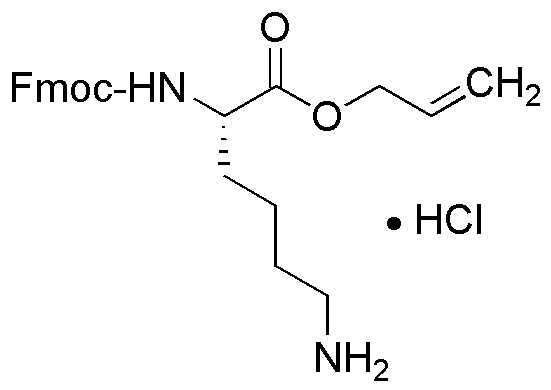Na-Fmoc-L-lysine allyl ester hydrochloride is widely utilized in research focused on
- Peptide Synthesis: This compound serves as a key building block in the synthesis of peptides, enabling researchers to create complex structures for studying biological functions and interactions.
- Drug Development: Its role in medicinal chemistry allows for the modification of drug candidates, enhancing their efficacy and bioavailability, which is crucial in developing new therapeutics.
- Bioconjugation: The allyl ester functionality facilitates bioconjugation processes, making it valuable in creating targeted drug delivery systems and improving the specificity of treatments.
- Protein Engineering: Researchers use this compound to introduce lysine residues into proteins, aiding in the study of protein structure and function, which is essential in biotechnology applications.
- Research in Cancer Therapy: Its applications extend to cancer research, where it helps in the design of peptide-based inhibitors that can selectively target cancer cells, offering potential advancements in treatment strategies.
General Information
Properties
Safety and Regulations
Applications
Na-Fmoc-L-lysine allyl ester hydrochloride is widely utilized in research focused on
- Peptide Synthesis: This compound serves as a key building block in the synthesis of peptides, enabling researchers to create complex structures for studying biological functions and interactions.
- Drug Development: Its role in medicinal chemistry allows for the modification of drug candidates, enhancing their efficacy and bioavailability, which is crucial in developing new therapeutics.
- Bioconjugation: The allyl ester functionality facilitates bioconjugation processes, making it valuable in creating targeted drug delivery systems and improving the specificity of treatments.
- Protein Engineering: Researchers use this compound to introduce lysine residues into proteins, aiding in the study of protein structure and function, which is essential in biotechnology applications.
- Research in Cancer Therapy: Its applications extend to cancer research, where it helps in the design of peptide-based inhibitors that can selectively target cancer cells, offering potential advancements in treatment strategies.
Documents
Safety Data Sheets (SDS)
The SDS provides comprehensive safety information on handling, storage, and disposal of the product.
Product Specification (PS)
The PS provides a comprehensive breakdown of the product’s properties, including chemical composition, physical state, purity, and storage requirements. It also details acceptable quality ranges and the product's intended applications.
Certificates of Analysis (COA)
Search for Certificates of Analysis (COA) by entering the products Lot Number. Lot and Batch Numbers can be found on a product’s label following the words ‘Lot’ or ‘Batch’.
Numéro de catalogue
Numéro de lot/série
Certificates Of Origin (COO)
This COO confirms the country where the product was manufactured, and also details the materials and components used in it and whether it is derived from natural, synthetic, or other specific sources. This certificate may be required for customs, trade, and regulatory compliance.
Numéro de catalogue
Numéro de lot/série
Safety Data Sheets (SDS)
The SDS provides comprehensive safety information on handling, storage, and disposal of the product.
DownloadProduct Specification (PS)
The PS provides a comprehensive breakdown of the product’s properties, including chemical composition, physical state, purity, and storage requirements. It also details acceptable quality ranges and the product's intended applications.
DownloadCertificates of Analysis (COA)
Search for Certificates of Analysis (COA) by entering the products Lot Number. Lot and Batch Numbers can be found on a product’s label following the words ‘Lot’ or ‘Batch’.
Numéro de catalogue
Numéro de lot/série
Certificates Of Origin (COO)
This COO confirms the country where the product was manufactured, and also details the materials and components used in it and whether it is derived from natural, synthetic, or other specific sources. This certificate may be required for customs, trade, and regulatory compliance.


